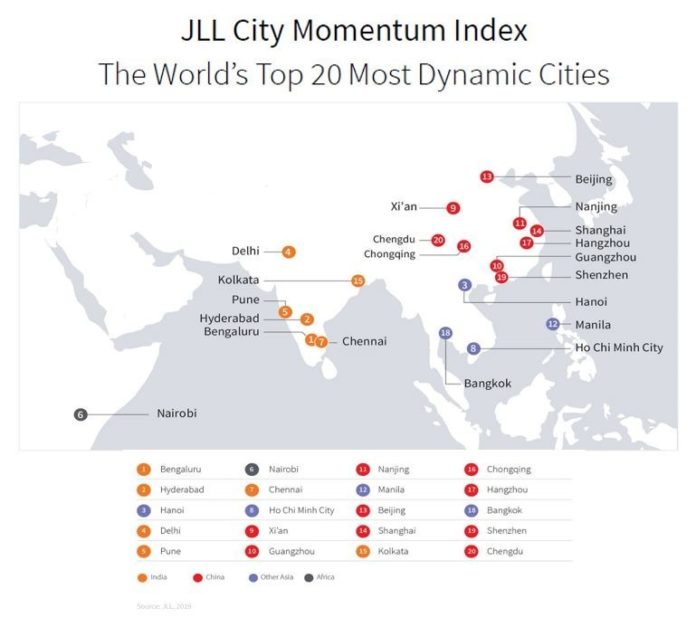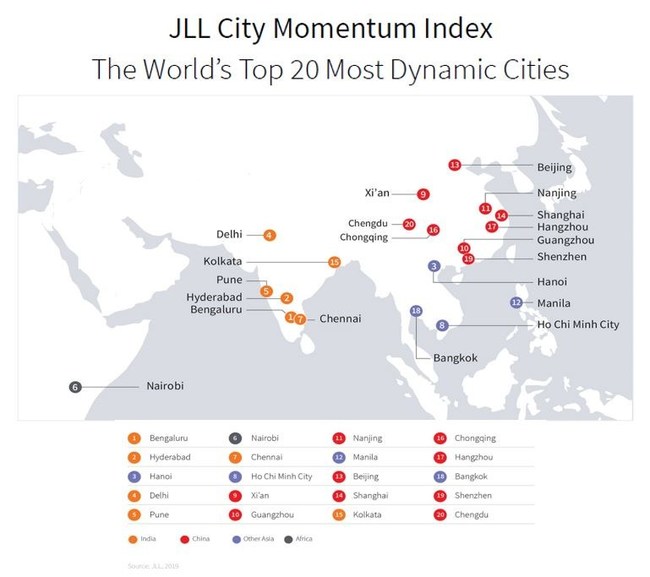
JLL’s City Momentum Index reveals where in the world to find highest levels of socio-economic and commercial real estate dynamism
CHICAGO, Jan. 14, 2019 /PRNewswire/ — Asia Pacific is home to 19 of the top 20 cities, highlighting the continuing shift of fast urban growth from the West to the East, according to the sixth City Momentum Index published by JLL (NYSE: JLL).
The absence of European and American cities demonstrates a marked East-West growth divide, reflecting Asia’scontinued rapid urbanization and economic growth, driven by globalization, innovation and demographic factors.


Overall, Indian and Chinese cities dominate the rankings, accounting for three quarters of the top 20. Leading the pack are Indian cities Bengaluru and Hyderabad, followed by Vietnam’s Hanoi in third place. The only non-Asian city on the list is Nairobi, in sixth place, which is heavily influenced by significant amounts of infrastructure-focused investment from China.
Jeremy Kelly, Director of Global Research at JLL says: “Asia continues to show strong momentum, with cities that are successfully expanding their innovation economy punching above their weight in terms of attracting capital, companies and people.
“It’s clear that the tech sector is a key driver of both real estate and economic momentum–driven by large technology firms as well as dynamic start-ups in cities like Bengaluru, Hyderabad, Ho Chi Minh City and Shenzhen.”
Although the global economic cycle is in its late stages, there are still many cities in the world where real estate and economic growth continue to be robust. But while strong growth brings opportunities for economic and social development, it also brings challenges that cities must address to ensure short-term growth transitions into long-term momentum. Investing in infrastructure and greater transparency is essential to facilitate this transition.
Kelly adds: “These cities need to address the environmental and social impacts of rapid growth such as social inequality, congestion and environmental degradation. The provision of smart, efficient and productive real estate and increased transparency are key factors in driving long-term, sustainable growth.”
Investment in transformative real estate drives sustainable growth
Thoughtful and innovative development–such as regeneration projects with a long-term vision that nurture new businesses and improve lives–is essential, as are large-scale infrastructure projects that help combat problems around congestion and improve accessibility, according to Kelly.
Manila (ranked 12 in this year’s Index), for example, is one of the densest cities in the world, with an expanding population. The government has committed to an extensive infrastructure building program, ‘Build Build Build’, which includes more than 2,000 projects. These are expected to improve congestion, increase power reliability, reduce the impact of climate change, and redevelop urban areas.
Smart infrastructure and sustainable technology create liveable cities
Technological innovation in the form of greener and smarter buildings also plays an important role in answering the environmental challenges brought about by rapid growth. The Chinese city of Xi’an, ranked ninth in this year’s Index, has installed an innovative 100-metre-tall air purifying tower to reduce smog and improve air quality.
Foreign Direct Investment crucial for long-term momentum
Sustainable long-term momentum and a maturing economy are often supported by long-term foreign direct investment (FDI) and transparent governance.
India’s fastest growing cities have been successful over recent years, attracting high levels of FDI, with structural reforms (including the Real Estate Regulation and Development Act), encouraging more real estate investment from foreign buyers. A similar story is playing out in Chinese cities, such as Beijing and Shanghai, which are both on the cusp of joining the ranks of the world’s transparent real estate markets.
“Transparency is vital in securing the long-term investment that leads to sustainable growth. With strong governance and planning, the private sector can work with city governments to drive change and bring benefits to the real estate market and wider commerciality of a city,” concludes Kelly.
For more information, download the City Momentum Index here: https://www.jll.co.uk/en/trends-and-insights/research/city-momentum-index-2019
Methodology
JLL’s City Momentum Index measures momentum for 131 of the world’s most commercially active cities by tracking a range of socio-economic and commercial real estate indicators over a three-year period to identify the urban economies and real estate markets undergoing the most rapid expansion. The City Momentum Index presents a weighted overall score for the sub-scores of 20 variables. For each variable the model calculates a score based on the city’s performance relative to the distribution of all 131 city regions, scaled from zero to one. The top-scoring city for each variable has a value of one, while the lowest-scoring city receives a value of zero. Variables focus on indicators of socio-economic momentum and commercial real estate momentum. All real-estate data is sourced to JLL. Non-real estate data is drawn from a wide range of sources that includes Oxford Economics, United Nations, ACI, GaWC and fDI Markets. The Index also sources data from many national statistical offices. To learn more about cities and real estate, visit www.jll.com/cities-research.
SOURCE JLL-IR



